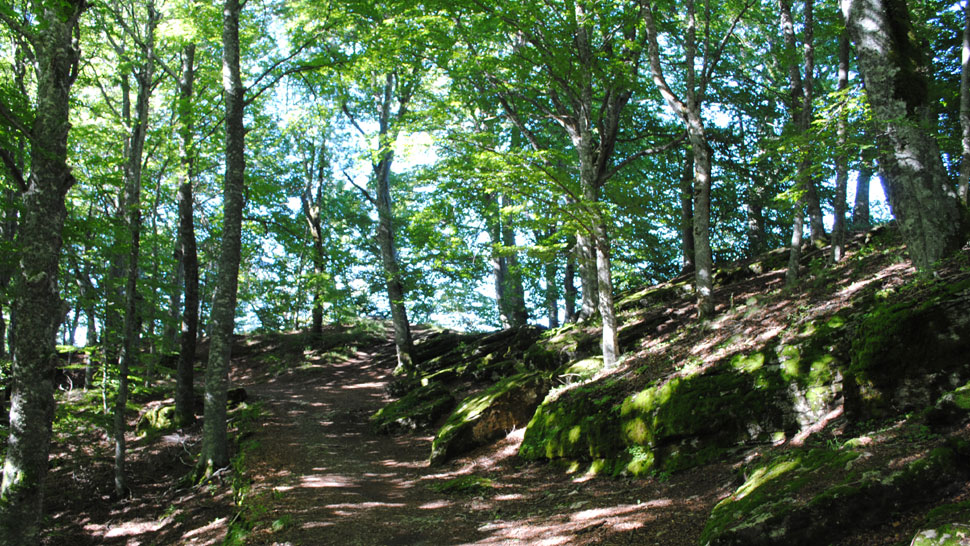PARCHI, RISERVE NATURALI
Back
Parco Nazionale delle Foreste Casentinesi

National Park of the Casentino Forests
The "National Park of the Casentino Forests, Mount Falterona and Campigna" is one of the most important areas of forest in Europe and Bagno di Romagna occupies a considerable and highly valuable section of its territory (5,053 hectares). The park was established by Law No. 305 in 1989 that was later ratified with the framework law No. 394 on protected areas in December 1991. It covers a total of 35,370 hectares that straddle the Tuscany and Romagna Apennines between the provinces of Forlì-Cesena, Arezzo and Florence. The towns of Chiusi della Verna, Bibbiena, Stia, Poppi, Pratovecchio, San Godenzo and Londa fall within the Tuscan side, while Tredozio, Portico-San Benedetto, Premilcuore, Santa Sofia and Bagno di Romagna are within the area comprised in Romagna.
Access to the park is permitted in line with the safeguards provided in national legislation and provisions. The Casentino State Forests lie completely within the park and are of exceptional natural value thanks to the fact that they have been properly managed and protected for a considerable length of time. The main heart of the Forests date back to medieval times: at that time certain parts belonged to monasteries and the Hospital of S. Maria Novella of Florence, and in the Romagna side to the Counts Guidi. For a number of centuries the woods were the property of the "Opera di S. Maria del Fiore" in Florence which entrusted their management to highly competent forestry workers; the timber that was produced was of high quality and was used in shipbuilding and for the construction of churches.
The work of the monks of Camaldoli was especially important as their use of the forest ensured respect for the environment. In more recent times, as agriculture spread, the forests became intensely exploited and the forests were to some extent altered and depleted. In 1837 the territory passed into the hands of the Grand Duchy of Tuscany, which placed it under the supervision of Karl Siemon to whom we owe the valuable work of reforestation and naturalisation of the forests. In 1914 the area became part of the State Forests.
Access to the park is permitted in line with the safeguards provided in national legislation and provisions. The Casentino State Forests lie completely within the park and are of exceptional natural value thanks to the fact that they have been properly managed and protected for a considerable length of time. The main heart of the Forests date back to medieval times: at that time certain parts belonged to monasteries and the Hospital of S. Maria Novella of Florence, and in the Romagna side to the Counts Guidi. For a number of centuries the woods were the property of the "Opera di S. Maria del Fiore" in Florence which entrusted their management to highly competent forestry workers; the timber that was produced was of high quality and was used in shipbuilding and for the construction of churches.
The work of the monks of Camaldoli was especially important as their use of the forest ensured respect for the environment. In more recent times, as agriculture spread, the forests became intensely exploited and the forests were to some extent altered and depleted. In 1837 the territory passed into the hands of the Grand Duchy of Tuscany, which placed it under the supervision of Karl Siemon to whom we owe the valuable work of reforestation and naturalisation of the forests. In 1914 the area became part of the State Forests.
Contacts
Telephone: 0039 0543971375 - Fax: 0039 0543973034
info@parcoforestecasentinesi.it - http://www.parcoforestecasentinesi.it
info@parcoforestecasentinesi.it - http://www.parcoforestecasentinesi.it
Getting here
ACCESS FROM THE ROMAGNA SIDE: A14 motorway exits: Faenza for Tredozio; Forlì for Portico-S. Benedetto, S.Sofia; Cesena Nord for Bagno di Romagna. - E45 highway: exit for Bagno di Romagna and then SP. 142 (formerly SS. 71) Mandrioli Pass road. The park can be visited throughout the year.
Tue, 23 Apr 2024 09:43:48 +0000












 Facebook
Facebook Instagram
Instagram Youtube
Youtube